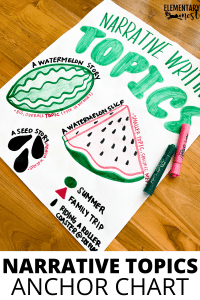
Narrative Writing is my personal favorite type of writing to teach. The creativity and possibilities that come with this type of writing are endless! Today, we are going to take a look at 7 strong anchor charts for teaching narrative writing. Anchor charts are always a great tool for introducing or even revisiting a skill. In this case, the anchor charts are going to help students better understand the requirements and structure of narrative writing.
Introduce the Narrative Writing Structure


First, students will need to know what Narrative Writing is! Students will be tasked with writing narrative stories throughout their education. The anchor chart above divides the topic into personal and fictional narrative writing. Initially, students will be writing stories about events that they experienced, personal narratives. However, writing those personal stories will help students develop writing skills that will enhance their fictional narratives, too!
Next, you will want to show students the narrative writing structure. This anchor chart displays the narrative writing structure as a hamburger [or veggie burger :)]. I like to think that this structure image helps students remember that you can fill your burger with yummy ingredients (events and details), but it also needs a top and bottom (an introduction and conclusion).
Teach Students to Focus on Small Moments

Now, students will need help narrowing their writing ideas down to a specific event. This concept is more difficult for students to understand than one would think. So, we like to use a watermelon as a metaphor.
The whole watermelon represents a broad topic or big idea, like “Summer.” You wouldn’t want to write about your entire summer in one story. So, you take a slice out of that watermelon. Maybe your family took a trip or did something fun together over the summer. The slice may represent a “Family Trip.” Within that slice, there are seeds or specific events/things that were memorable on the trip. For example, maybe it was your first time riding a big roller coaster, you made a friend at the playground, built a sandcastle at the beach, made cookies with your grandmother, etc.
Choosing one of those memories and zooming in on the details and feelings of the moment will make for a much better story than simply writing about summer.
Focus on Aspects of the Body of Writing


Our next Narrative Writing Anchor Chart will focus in on the Body of the piece. This will be all of those yummy ingredients within your story burger! You will want students to remember that a story has a beginning, middle, and end. They also need to know that within those parts, there needs to be detail and description that engages the reader. *This chart can also be made with a simple, 3-row chart where you could provide an example of each event with details. OR laminate it and reuse it over and over!
Feelings and actions are very important to narrative writing. I recommend having a mini-lesson where students can get involved in the making of a feelings and actions anchor chart. Discuss different feelings and emotions you may experience during a memorable event. Then, talk about the actions that you may do during the event or during those emotions.
Teaching Introductions and Conclusions Explicitly


Finally, you are going to need to talk about those buns! The introduction and conclusion parts of your story burger are just as important as the middle. Many times, it is more effective to write introductions and conclusions after the body of the piece has been written. Be sure to provide examples of different types of hooks and closings from narrative stories you may have read. This is a great opportunity to refer back to mentor texts you have already read. Revisiting just the introduction and conclusion, students will remember how those stories were as readers. It will help them, creatively, and keep them developing their skill!
These simple narrative writing anchor charts are going to be great tools to refer back to throughout the year!
Interested in Free Graphic Organizers for Your Writing Unit?
Or Do You Want Ready-Made Lesson Plans for Narrative Writing?
If you’re interested in getting your students to master writing without having to spend hours on planning and prep, I have all-inclusive units for you! These no-prep units have everything you need to teach opinion writing in your classroom!





Narrative Units come complete with anchor charts, lesson plans, graphic organizers, writing prompts, and more! Click the button for your grade-level below:


















